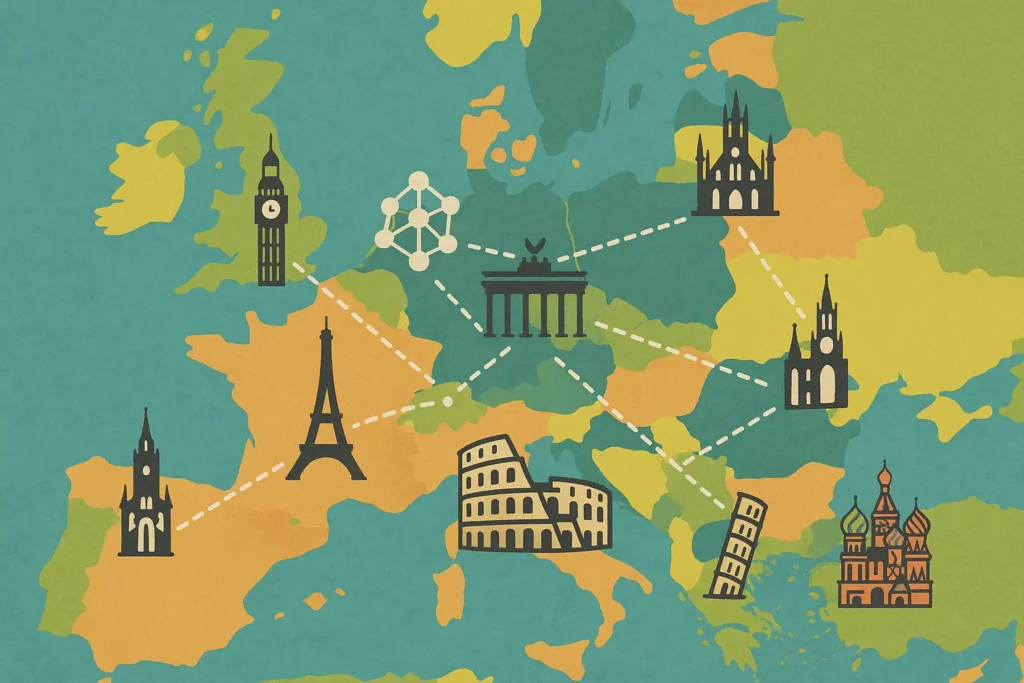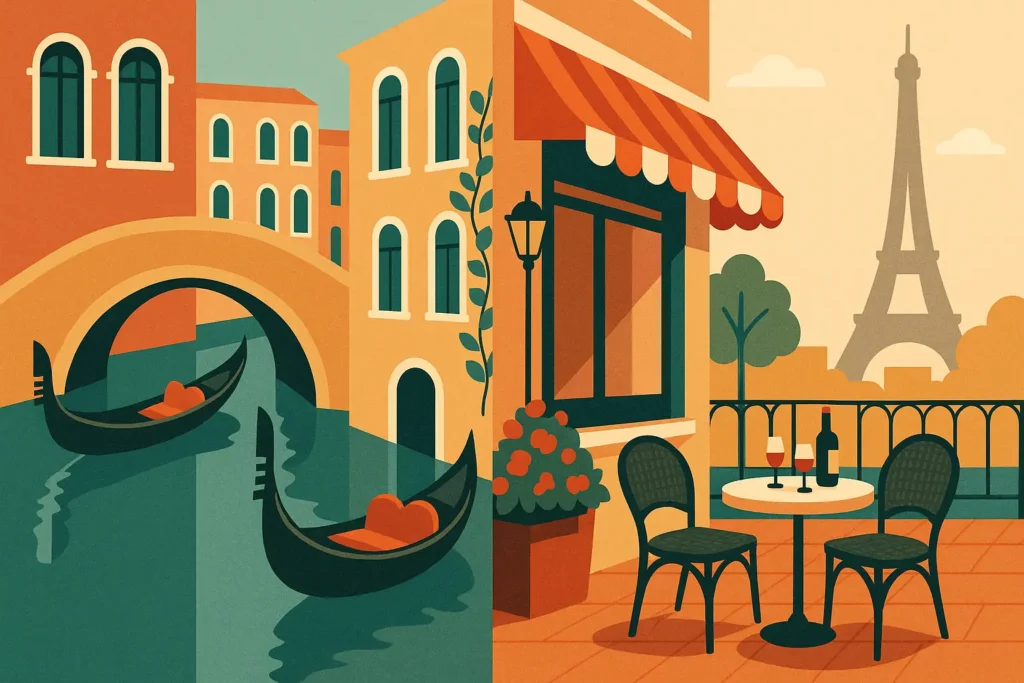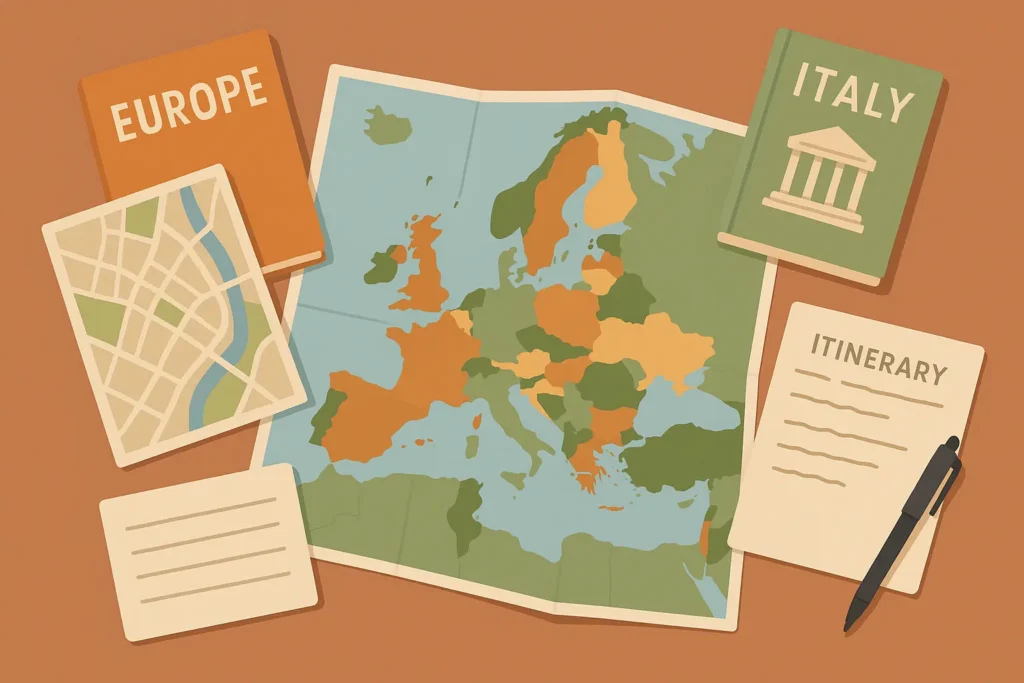So here’s the deal: 75% of Europeans are planning to travel in the coming months, up 6% from last year, according to recent European Travel Commission data. Three years ago, I was staring at my laptop at 2 AM, completely overwhelmed by all the europe travel itinerary options out there. Should I chase the Northern Lights in Norway or drink wine in Tuscany? The decision paralysis was real – and I was terrified of making expensive mistakes.
Skip the stress—plan smarter with our Vacation Planner and create a Europe itinerary that fits your travel style and budget.
Look, planning a European trip doesn’t have to drain your savings or leave you second-guessing every choice. Whether you’re dreaming of those Instagram-worthy canal dinners in Venice (they’re touristy but honestly still magical), hiking in the Alps, or wandering through medieval towns that look like something out of a fairy tale, the right europe itinerary turns chaos into memories you’ll actually want to talk about.
Quick Resources:
• Build your dream itinerary step-by-step with our Vacation Planner
• Simplify your group adventure using the Bachelorette Party Planner
• Keep your travel spending on track with the free Bachelorette Budget Calculator
• Explore all our Wedding & Travel Tools for seamless planning
I’ve broken down 25 european itinerary options that actually work in the real world. Each one includes honest budget breakdowns (because those daily estimates can sneak up on you fast), timing advice that won’t leave you melting in Rome in August, and transportation tips from someone who’s made every mistake in the book. From budget Eastern European adventures where $50 goes surprisingly far to luxury escapes where money is no object – there’s something here that’ll work for you.
The Quick Version
- How long you go matters: Quick city-hopping (2-3 days each) works great for first-timers, but staying put longer (5+ days) lets you actually experience places
- Budget reality check: Eastern Europe can cost as little as $50/day, but fancy trips can hit $800/day faster than you think
- Timing is everything: Summer = crowds and high prices, spring/fall = the sweet spot most people miss
- Getting around: Train passes are great for Western Europe, budget airlines work for long distances, rental cars are perfect for countryside (but parking in cities is a nightmare)
- Know what you actually like: Art lovers need different trips than hikers or food obsessives
- Eastern Europe is incredibly underrated – authentic experiences without the Western European price tag
- Sometimes it’s worth getting help with complex trips so you can enjoy planning instead of stressing about logistics
Stuff You Need to Figure Out First
Before we dive into specific trips, let’s talk about the decisions that’ll shape your entire European adventure. How long you can go, what you want to spend, when you can travel, how you want to get around – these aren’t just details, they’re the foundation of whether your trip is amazing or exhausting.
How Fast Do You Want to Move?
This is huge. City-hoppers who love cramming in maximum variety do great with 2-3 days per place. You’ll see all the famous stuff and have great stories, but you’ll also be pretty tired by the end. I learned this the hard way trying to do 8 countries in 10 days – I spent more time in airports than actually sightseeing.
Slow travelers who prefer 4-7 days per spot get to dig deeper. You’ll find those neighborhood cafes, stumble into local events, and actually remember what you did instead of everything blurring together. Plus, you won’t feel like you need a vacation from your vacation.
Whether you’re a city-hopper or a slow wanderer, the Vacation Planner helps you structure your perfect-paced European adventure.
Factor in travel days and jet lag recovery – especially if you’re coming from across the Atlantic. Nobody tells you this, but European breakfast is basically bread and coffee, so pack some granola bars if you need real food in the morning.
Money Talk (Let’s Be Honest)
Your budget shapes literally everything, and those daily estimates add up faster than you think. Here’s the real breakdown:
| How You Roll | Daily Reality | Where You Sleep | What You Eat | How You Get Around |
|---|---|---|---|---|
| Broke College Kid | $50-100 | Hostels, maybe some sketchy places | Street food, grocery stores | Your feet, buses |
| Normal Human | $100-150 | Decent hotels, nice hostels | Local restaurants, markets | Trains, some flights |
| Comfortable | $150-250 | Good hotels, cute B&Bs | Restaurant meals, food tours | Fast trains, domestic flights |
| Fancy | $250-400 | Really nice hotels | Fine dining, wine tastings | First-class everything |
| Money No Object | $400+ | Five-star hotels, castles | Michelin stars, private chefs | Private transfers, business class |
Don’t forget the sneaky costs – city taxes, tips, and those “just one more” souvenir purchases. I thought I could stick to $75/day in Eastern Europe until I discovered Hungarian thermal baths and Czech beer prices.
Keep those hidden expenses in check with the free Bachelorette Budget Calculator—your wallet will thank you later.
When to Go (This Actually Matters)
Europe’s seasons will make or break your trip. Summer (June-August) gives you warm weather and long days, but also crushing crowds and prices that’ll make your eyes water. I once paid $200/night for a basic room in Venice in July that cost $80 in September.
Spring (April-May) and fall (September-October) are the secret sweet spots – good weather, reasonable crowds, and your money goes further. Winter (November-March) means short days and cold, but also Christmas markets, fewer tourists, and serious savings.
Use the Vacation Planner to time your trip perfectly and dodge the crowds without missing the magic.
Real story: My friend Sarah was planning a Mediterranean trip for July, looking at $200+ hotel nights and crowds everywhere. She shifted to late September, saved 40% on hotels, enjoyed perfect 75°F weather, and actually got restaurant reservations. Her sunset gondola ride was romantic instead of a traffic jam.
Getting Around Europe
Europe’s transportation is actually pretty great once you figure out the system. Train passes work well for Western Europe but get expensive fast. Budget airlines are cheap but annoying – that “quick” 2-hour flight to Barcelona turns into a whole day when you factor in airports.
Rental cars give you total freedom and are perfect for wine regions or countryside, but good luck parking in any major city. I spent an hour looking for parking in Florence and ended up walking farther than if I’d just taken the train.
Perfect for Your First Time in Europe (5 Trips)
These five europe trip itinerary options are designed for people who want to see the famous stuff without making rookie mistakes. They hit the highlights, have good transportation connections, and won’t leave you completely exhausted.
1. The Classic Greatest Hits Tour (3-4 weeks)
London → Paris → Amsterdam → Berlin → Prague → Vienna → Rome → Barcelona
This is the trip everyone thinks about when they picture Europe. You’ll see all the postcard places – Big Ben, the Eiffel Tower, Anne Frank House, Brandenburg Gate, Prague Castle, Schönbrunn Palace, the Colosseum, and Sagrada Familia. It’s touristy as hell, but honestly, these places are famous for good reasons.
Give yourself 3-4 days in each city. London’s got the royal stuff and surprisingly good food, Paris is exactly as romantic as you think, Amsterdam is way more than just the coffee shops, Berlin will teach you more history than any textbook, Prague looks like a fairy tale, Vienna has the best coffee culture, Rome will blow your mind, and Barcelona has beaches AND culture.
Reality check: This is a lot of moving around. You’ll be tired. But you’ll also have incredible stories and photos that’ll make everyone jealous.
Daily cost: $150-300
Best time: April-May or September-October
Getting around: Mix of trains and flights
How long: 21-28 days
2. Western Europe’s Greatest Hits (2 weeks)
Paris → Brussels → Amsterdam → Cologne → Munich → Zurich → Milan → Nice
This europe itinerary focuses on Western Europe’s best stuff with excellent train connections. French elegance in Paris, Belgian chocolate and beer in Brussels (seriously, the chocolate is ridiculous), Dutch culture in Amsterdam, German history in Cologne, Bavarian traditions in Munich, Swiss Alps beauty in Zurich, Italian fashion in Milan, and French Riviera glamour in Nice.
The trains are fast, comfortable, and actually fun. You’ll see countryside views instead of airport ceilings, and train stations are usually right in city centers.
Daily cost: $120-250
Best time: May-June or September
Getting around: Mostly trains
How long: 14 days
3. Mediterranean Coast Road Trip (2-3 weeks)
Barcelona → Nice → Monaco → Cinque Terre → Rome → Naples → Athens → Santorini
Follow the Mediterranean coast for sun, sea, and some of the most beautiful scenery you’ll ever see. Barcelona’s got Gaudí architecture and beach vibes, the French Riviera is as glamorous as the movies, Cinque Terre is those colorful cliff towns from Instagram, Rome is Rome, Naples has the world’s best pizza, Athens brings the ancient history, and Santorini delivers those sunset photos.
Fair warning: this involves some island hopping and ferry schedules. But the Greek islands are worth the logistics headaches.
Daily cost: $140-280
Best time: May-June or September-October
Getting around: Flights and ferries
How long: 16-21 days
4. Central Europe Discovery (10-14 days)
Berlin → Prague → Vienna → Budapest → Krakow
This region gives you incredible bang for your buck while delivering serious history and architecture. Berlin’s modern German culture, Prague’s medieval charm, Vienna’s imperial elegance, Budapest’s thermal baths and ruin pubs, and Krakow’s preserved Polish heritage.
The value here is insane compared to Western Europe, and the history lessons are intense. Plus, the beer is cheap and excellent everywhere.
Map out your Central European adventure with our Vacation Planner for an unforgettable, budget-friendly itinerary.
Daily cost: $80-180
Best time: April-May or September-October
Getting around: Trains and buses
How long: 10-14 days
5. Scandinavian Adventure (2 weeks)
Copenhagen → Stockholm → Oslo → Bergen → Reykjavik
Nordic culture, design, and natural beauty across five distinctive capitals. Copenhagen’s hygge and design, Stockholm’s innovation and archipelago, Oslo’s culture and fjord access, Bergen’s dramatic fjords, and Reykjavik’s otherworldly landscapes.
Warning: this is expensive. Like, really expensive. But the quality of everything is incredible, and these might be the happiest people on Earth.
Daily cost: $200-400
Best time: June-August
Getting around: Flights and ferries
How long: 14 days
History Buff Adventures (5 Trips)
If you’re the type who reads historical plaques and actually enjoys museums, these five trips will feed your soul. From ancient civilizations to medieval towns, these european itinerary options focus on the stories behind the stones.
6. Ancient Civilizations Deep Dive (3 weeks)
Rome → Athens → Istanbul → Dubrovnik → Split → Venice → Florence
Follow the footsteps of empires from Roman ruins to Byzantine churches to Renaissance art. Rome’s Colosseum and Forum, Athens’ Acropolis, Istanbul’s Hagia Sophia and Blue Mosque, Dubrovnik’s medieval walls, Split’s Diocletian’s Palace, Venice’s maritime empire, and Florence’s Renaissance birthplace.
This trip is like a history textbook come to life. You’ll stand where Caesar walked, see where democracy was born, and understand how different empires shaped Europe.
Daily cost: $130-250
Best time: April-May or September-October
Getting around: Mix of flights and trains
How long: 21 days
7. Medieval Europe Time Travel (2-3 weeks)
Edinburgh → York → Bruges → Rothenburg → Cesky Krumlov → Tallinn → Krakow
Journey through Europe’s best-preserved medieval towns. Edinburgh’s Royal Mile, York’s city walls, Bruges’ canals and medieval architecture, Rothenburg’s fairy-tale German streets, Cesky Krumlov’s UNESCO World Heritage center, Tallinn’s intact medieval old town, and Krakow’s magnificent medieval square.
These places feel frozen in time but have modern amenities. It’s like stepping into a movie set, except it’s all real.
Daily cost: $110-220
Best time: May-September
Getting around: Mix of flights, trains, and buses
How long:How long: 18-21 days
8. Art Lover’s European Circuit (2-3 weeks)
Paris → Madrid → Barcelona → Florence → Venice → Vienna → Amsterdam → London
Hit every major art collection in Europe. The Louvre and Musée d’Orsay in Paris, Prado and Reina Sofia in Madrid, Picasso Museum in Barcelona, Uffizi in Florence, Peggy Guggenheim in Venice, Kunsthistorisches in Vienna, Rijksmuseum and Van Gogh Museum in Amsterdam, and Tate Modern in London.
Real story: My friend Marcus, a graphic designer, spent three weeks on this circuit. He bought museum passes in each city, saving over $300 while skipping lines. His highlight was seeing Van Gogh’s “Starry Night Over the Rhône” in person after studying it in art school. He scheduled morning museum visits to avoid crowds and spent afternoons exploring neighborhoods that inspired famous artists.
Daily cost: $180-320
Best time: Year-round (mostly indoor activities)
Getting around: High-speed trains and flights
How long: 21 days
9. World War History Trail (2 weeks)
London → Normandy → Paris → Berlin → Prague → Krakow → Munich
Follow 20th-century European history through significant wartime locations. London’s Churchill War Rooms, Normandy’s D-Day beaches, Paris’ Liberation history, Berlin’s divided city legacy, Prague’s WWII and Communist history, Krakow’s proximity to Auschwitz, and Munich’s Nazi origins.
This is heavy stuff, but essential. You’ll understand European history in a completely different way after seeing these places in person.
Daily cost: $120-240
Best time: April-October
Getting around: Trains and rental car for Normandy
How long: 14 days
10. Religious and Spiritual Journey (2-3 weeks)
Vatican City → Assisi → Lourdes → Santiago de Compostela → Fatima → Montserrat → Taizé
Explore Europe’s most significant religious and spiritual sites. Vatican City’s papal headquarters, Assisi’s Franciscan heritage, Lourdes’ pilgrimage site, Santiago de Compostela’s Camino endpoint, Fatima’s Marian apparitions, Montserrat’s mountain monastery, and Taizé’s ecumenical community.
Whether you’re religious or just curious, these places have incredible spiritual energy and beautiful architecture.
Daily cost: $90-180
Best time: April-October
Getting around: Mix of trains, buses, and walking
How long: 18-21 days
Outdoor Adventures (5 Trips)
For those who prefer mountains to museums and trails to tourist traps, these five adventures showcase Europe’s stunning natural side. Fair warning: some of these are expensive, but the views are worth every penny.
11. Alpine Adventure Circuit (2-3 weeks)
Chamonix → Zermatt → Interlaken → Innsbruck → Salzburg → Munich
Experience the European Alps at their most spectacular. Chamonix’s legendary mountaineering beneath Mont Blanc, Zermatt’s car-free Alpine charm with Matterhorn views, Interlaken’s adventure sports paradise, Innsbruck’s Austrian Alpine culture, Salzburg’s musical heritage amid mountains, and Munich’s beer gardens with Alpine backdrop.
The hiking is incredible, but those beautiful cobblestone streets will make your feet hate you after day three. Pack good walking shoes.
Daily cost: $200-350
Best time: June-September for hiking, December-March for skiing
Getting around: Trains and rental car
How long: 18-21 days
12. Nordic Natural Wonders (2-3 weeks)
Oslo → Bergen → Trondheim → Tromsø → Reykjavik → Akureyri → Faroe Islands
Experience Scandinavia’s dramatic natural beauty and unique culture. Oslo’s modern design, Bergen’s fjord gateway, Trondheim’s colorful wooden architecture, Tromsø’s Northern Lights and midnight sun, Reykjavik’s geothermal wonders, Akureyri’s whale watching, and the Faroe Islands’ remote Atlantic beauty.
This is expensive as hell, but the landscapes are otherworldly. Think Lord of the Rings meets modern Scandinavian design.
Daily cost: $250-450
Best time: June-August for midnight sun, November-March for Northern Lights
Getting around: Flights and ferries
How long: 18-24 days
13. Coastal and Island Hopping (3-4 weeks)
Lisbon → Porto → San Sebastian → Barcelona → Nice → Cinque Terre → Greek Islands → Croatia
Follow Europe’s diverse coastlines from Atlantic to Mediterranean. Portugal’s Atlantic charm, Spain’s Basque and Catalonian shores, France’s glamorous Riviera, Italy’s dramatic coastal villages, Greece’s island paradise, and Croatia’s Adriatic beauty.
Ferry schedules can be a pain, but waking up on a Greek island makes up for any logistics headaches.
Daily cost: $140-280
Best time: May-October
Getting around: Flights, trains, and ferries
How long: 21-28 days
14. Eastern European Nature Discovery (2 weeks)
Krakow → High Tatras → Transylvania → Bulgarian Mountains → Albanian Alps
Explore Eastern Europe’s lesser-known natural wonders without the Western European price tags. Poland’s Tatra Mountains, Slovakia’s High Tatras peaks, Romania’s Carpathian Mountains (yes, Dracula’s castle region), Bulgaria’s Rila and Pirin ranges, and Albania’s dramatic northern Alps.
Incredible scenery, fewer crowds, and your money goes way further. The hiking is world-class but without the Swiss prices.
Daily cost: $60-140
Best time: May-September
Getting around: Rental car recommended
How long: 14-18 days
15. British Isles Natural Heritage (2-3 weeks)
London → Lake District → Edinburgh → Highlands → Belfast → Dublin → Cork
Discover the diverse landscapes of Britain and Ireland. London’s surprising green spaces, Lake District’s poetic landscapes, Edinburgh’s volcanic setting, Scottish Highlands’ dramatic scenery, Belfast’s Giant’s Causeway access, Dublin’s literary heritage, and Cork’s southern Irish charm.
The weather is unpredictable, but the landscapes are magical when the sun comes out (and moody and beautiful when it doesn’t).
Daily cost: $180-320
Best time: May-September
Getting around: Rental car and trains
How long: 18-21 days
Food and Wine Trips (4 Trips)
If you’re the type who plans trips around meals, these four europe travel itinerary options will feed your soul (and your stomach). From prestigious wine regions to local food markets, these trips are all about the flavors of Europe.
16. European Wine Regions Grand Tour (3-4 weeks)
Bordeaux → Burgundy → Champagne → Rhine Valley → Tuscany → Rioja → Douro Valley
This is the ultimate wine lover’s european itinerary. Bordeaux’s legendary châteaux, Burgundy’s terroir obsession, Champagne’s bubbly heritage, Rhine Valley’s riesling perfection, Tuscany’s chianti countryside, Rioja’s tempranillo excellence, and Douro Valley’s port origins.
You’ll need a rental car for most of this, and designated drivers are essential. The tastings add up fast, but the education is incredible.
Wine Region Breakdown:
- Bordeaux (4 days): Château visits, wine classes, Saint-Émilion charm
- Burgundy (3 days): Domaine visits, harvest participation if you’re lucky
- Champagne (3 days): Reims cathedral, cellar tours, small producer visits
- Rhine Valley (4 days): Castle hotels, vineyard hiking, riesling heaven
- Tuscany (5 days): Chianti countryside, cooking classes, olive oil tastings
- Rioja (3 days): Traditional and modern bodegas, Bilbao Guggenheim
- Douro Valley (3 days): Quinta visits, river cruise, Porto exploration
Daily cost: $200-400
Best time: September-October for harvest season
Getting around: Rental car essential
17. Mediterranean Food Trail (2-3 weeks)
Barcelona → Lyon → Bologna → Naples → Athens → Istanbul → Split
Follow the Mediterranean diet to its sources. Barcelona’s tapas and Catalonian cuisine, Lyon’s French gastronomic capital status, Bologna’s pasta and Parmigiano-Reggiano origins, Naples’ pizza birthplace (seriously, it’s life-changing), Athens’ Greek taverna culture, Istanbul’s Turkish and Ottoman flavors, and Split’s fresh Adriatic seafood.
Every meal is a revelation. You’ll gain weight and not care.
Daily cost: $120-240
Best time: April-June, September-October
Getting around: Mix of trains and flights
How long: 18-21 days
18. Northern European Comfort Food Journey (2 weeks)
Copenhagen → Stockholm → Helsinki → Tallinn → Riga → Vilnius → Warsaw → Berlin
Discover Nordic and Baltic culinary traditions. Copenhagen’s New Nordic cuisine and smørrebrød, Stockholm’s modern Swedish cuisine and traditional meatballs, Helsinki’s reindeer and cloudberry specialties, Tallinn’s medieval-inspired Estonian dishes, Riga’s hearty Latvian cuisine, Vilnius’ Lithuanian cepelinai, Warsaw’s pierogi and vodka, and Berlin’s currywurst and beer gardens.
The comfort food is incredible, especially when it’s cold outside. And the beer is cheap and excellent everywhere.
Daily cost: $150-280
Best time: May-September
Getting around: Flights and ferries
How long: 14 days
19. Cheese and Dairy Delights Tour (2 weeks)
Amsterdam → Brussels → Paris → Swiss Alps → Northern Italy → Bavaria
Explore Europe’s finest cheese-making regions. Amsterdam’s aged goudas and cheese markets, Brussels’ artisanal cheeses and chocolate pairings, Paris’ fromageries and cheese courses, Swiss Alps’ gruyère and emmental origins, Northern Italy’s parmigiano-reggiano and gorgonzola production, and Bavaria’s beer and cheese combinations.
You’ll learn more about cheese than you ever thought possible. And yes, you can ship some home.
Daily cost: $130-250
Best time: Year-round
Getting around: Trains and rental car
How long: 14 days
Romantic and Fancy Getaways (3 Trips)
These three premium trips focus on romance and luxury. If you’re celebrating something special or just want to splurge, these europe itinerary options spare no expense for magical experiences.
20. Ultimate Romantic European Getaway (2-3 weeks)
Paris → Venice → Santorini → Prague → Vienna → Swiss Alps → Tuscany
This is the trip for anniversaries, honeymoons, or when you just want to feel like you’re in a romantic movie. Paris’ Seine river cruises and candlelit dinners, Venice’s gondola rides and palace hotels, Santorini’s sunset views and infinity pools, Prague’s fairy-tale architecture and classical concerts, Vienna’s waltz culture and elegant cafes, Swiss Alps’ mountain retreats and spa treatments, and Tuscany’s vineyard estates and cooking classes.
Luxury experiences include:
- Private Seine river dinner cruise in Paris
- Exclusive after-hours Doge’s Palace tour in Venice
- Private yacht sunset cruise in Santorini
- Classical concert in Prague’s historic venues
- Waltz lessons and opera in Vienna
- Helicopter tours of the Swiss Alps
- Private cooking classes in Tuscan villas
It’s expensive, but some experiences are worth it. That romantic gondola ride in Venice? Touristy as hell, but honestly still pretty magical.
Daily cost: $400-800
Best time: April-June, September-October
Getting around: First-class trains and private transfers
How long: 18-21 days
21. Luxury City Break Circuit (10-14 days)
London → Paris → Milan → Monaco → Barcelona
Experience Europe’s most sophisticated cities with premium everything. London’s luxury shopping and afternoon tea, Paris’ haute couture and Michelin stars, Milan’s fashion scene and design hotels, Monaco’s casino glamour and yacht culture, and Barcelona’s modernist architecture and beach clubs.
When money is no object, Europe delivers incredible experiences. Just don’t look at your credit card statements.
Daily cost: $500-1000
Best time: Year-roun
Best time: Year-round
Getting around: Business class flights
How long: 10-14 days
22. Castle and Palace Romance (2 weeks)
Edinburgh → Loire Valley → Bavaria → Vienna → Prague → Transylvania
Stay in converted castles and palaces while exploring royal heritage. Edinburgh Castle and Royal Mile romance, Loire Valley château hotels and wine tastings, Bavarian castle hotels near Neuschwanstein, Vienna’s imperial palace hotels and classical music, Prague’s castle district and boutique palace hotels, and Transylvania’s medieval castle accommodations.
Living in castles is as cool as it sounds, though some have better heating than others.
Daily cost: $250-500
Best time: May-September
Getting around: Rental car and trains
How long: 14 days
Broke but Still Want to Travel (3 Trips)
These three value-focused europe travel itinerary options prove incredible European experiences don’t require trust funds. With smart planning and realistic expectations, you can have amazing adventures on tight budgets.
23. Eastern European Budget Explorer (3-4 weeks)
Warsaw → Krakow → Budapest → Belgrade → Sofia → Bucharest → Kiev → Vilnius
Discover Eastern Europe’s incredible value and authentic culture. Poland’s historical cities and hearty cuisine, Hungary’s thermal baths and ruin pubs, Serbia’s vibrant nightlife and Danube beauty, Bulgaria’s mountain monasteries and Black Sea coast, Romania’s Carpathian castles and medieval towns, Ukraine’s cultural heritage and architectural gems, and Lithuania’s Baltic charm.
Budget reality:
- Accommodation: $15-40/night (hostels, guesthouses)
- Food: $10-25/day (local restaurants, markets)
- Transportation: $20-50/day (buses, trains)
- Activities: $5-20/day (walking tours, museums)
- Total: $50-135/day
Real story: College student Jake spent four weeks here on $75/day. He stayed in hostels, used public transport, and ate at local markets. His highlight was Budapest’s Széchenyi Thermal Baths for $20, followed by $2 beers at ruin pubs. He saved money using overnight trains as accommodation between distant cities. Total trip cost: $2,100 including flights.
Daily cost: $50-135
Best time: May-September
Getting around: Buses and budget trains
How long: 21-28 days
24. Backpacker’s Western Europe (3 weeks)
Amsterdam → Berlin → Prague → Vienna → Budapest → Munich → Zurich → Barcelona
Experience Western Europe’s highlights while controlling costs through hostels, free activities, and smart transportation. Amsterdam’s free parks and affordable food markets, Berlin’s free historical sites and cheap beer, Prague’s budget-friendly culture and free walking tours, Vienna’s free concerts and affordable coffee culture, Budapest’s thermal baths and ruin bars, Munich’s beer gardens and free museums, Zurich’s free lake activities, and Barcelona’s free beaches and affordable tapas.
Western Europe can be budget-friendly if you’re strategic about it.
Daily cost: $80-160
Best time: April-May, September-October
Getting around: Eurail pass and budget airlines
How long: 21 days
25. Mediterranean Budget Island Hopping (2-3 weeks)
Athens → Greek Islands → Sicily → Sardinia → Mallorca → Valencia
Explore Mediterranean islands and coasts on a budget using ferries, hostels, and local transportation. Athens’ affordable accommodations and free archaeological sites, Greek islands’ budget ferries and camping options, Sicily’s inexpensive local cuisine and free beaches, Sardinia’s wild camping and affordable agritourism, Mallorca’s budget accommodations away from resort areas, and Valencia’s affordable Spanish culture and free city beaches.
Island life doesn’t have to cost a fortune if you avoid the resort areas and tourist traps.
Daily cost: $70-150
Best time: May-June, September-October (avoid peak summer prices)
Getting around: Ferry passes and budget airlines
How long: 18-21 days
How These Trips Actually Stack Up
Let me break down how different european itinerary options align with what you actually care about. This analysis helps you pick the right trip based on your real priorities instead of just pretty pictures.
Speed vs. Depth Trade-offs
Fast-paced (2-3 days per place): Grand European Tour, Western Europe Highlights, Mediterranean Coast work great if you want maximum variety and don’t mind living out of a suitcase.
Medium pace (3-5 days per place): Cultural trips, wine tours, romantic escapes let you dig deeper while still covering ground.
Slow travel (5+ days per place): Luxury city breaks, specialized interest tours give you time to really experience places instead of just checking them off a list.
Budget Reality Check
Seriously broke ($50-100/day): Eastern European Explorer, some Mediterranean island routes deliver authentic experiences at rock-bottom prices.
Normal budget ($100-150/day): Backpacker routes, Central European trips prove popular places can be affordable with smart planning.
Comfortable ($150-250/day): Most classic routes, cultural tours, moderate adventures provide good experiences without breaking the bank.
High-end ($250-400/day): Alpine adventures, Nordic tours, wine regions require serious investment but deliver exceptional experiences.
Money no object ($400+/day): Romantic getaways, luxury city breaks, castle stays spare no expense for ultimate comfort.
| Trip Type | Best Season | How to Get Around | How Long | Daily Reality |
|---|---|---|---|---|
| First-Timer Classics | Apr-May, Sep-Oct | Trains + Flights | 14-28 days | $120-300/day |
| History Buff | Year-round | Mixed transport | 14-21 days | $110-320/day |
| Outdoor Adventures | Jun-Sep | Rental car + Trains | 14-24 days | $140-450/day |
| Food and Wine | Sep-Oct | Rental car essential | 14-28 days | $120-400/day |
| Romantic/Luxury | Apr-Jun, Sep-Oct | First-class/Private | 10-21 days | $250-800/day |
| Budget Conscious | May-Sep | Buses + Budget trains | 18-28 days | $50-160/day |
When Timing Actually Matters
Year-round works: Art tours, city-focused trips, cultural stuff work regardless of weather since you’re mostly indoors.
Spring/fall are perfect: Most European routes benefit from avoiding crowds and extreme weather while keeping costs reasonable.
Summer is essential: Nordic countries, Alpine hiking, island hopping need warm weather for the full experience.
Winter has perks: Christmas markets, Northern Lights, winter sports turn cold weather into unique advantages.
Transportation Reality
Train-friendly: Western Europe routes, Central European circuits benefit from excellent rail connections and city-center stations.
Flight-dependent: Nordic tours, island hopping, long distances require air travel due to geography.
Car-essential: Wine regions, rural areas, Alpine adventures need rental cars for flexibility and accessing remote spots.
Mixed works best: Most comprehensive tours combine different transport methods for optimal cost and convenience.
When to Get Help Planning
Look, planning a big European trip can get overwhelming fast. Multiple countries, different currencies, train schedules, hotel bookings, restaurant reservations – it adds up quickly. Sometimes it’s worth paying someone to handle the logistics so you can actually enjoy the planning process instead of stressing about train schedules at 2 AM.
Complex European itineraries involving multiple countries, varying budgets, and different group preferences benefit from professional help. Think about it – you wouldn’t plan a wedding without considering expert support, and a big European adventure deserves the same thoughtful approach.
Whether you’re planning a pre-wedding European adventure, a honeymoon across romantic cities, or organizing a group trip where everyone has different ideas about what they want to do, having someone who knows the ins and outs can save your sanity. From handling unexpected travel disruptions (and they will happen) to discovering those hidden local gems that align with your interests, expert assistance ensures your adventure becomes the magical experience you dreamed about instead of a logistics nightmare.
For couples planning European honeymoons or groups with different travel styles, varying budgets, accommodation preferences, and activity interests, the complexity multiplies fast. Professional planning removes the guesswork and provides calm, expert guidance during what should be exciting preparation time, not stressful research marathons.
Planning a honeymoon or group getaway? Our Bachelorette Party Planner helps manage every detail—from logistics to fun.
Ready to turn your European travel dreams into reality without the planning headaches? Bridesmaid for Hire’s planning expertise extends beyond weddings to help create seamless, unforgettable European adventures. Our 24/7 support, unbiased advice, and expert problem-solving ensure your trip planning becomes as enjoyable as the journey itself. Contact us today to start planning your perfect European escape.
Take the stress out of your multi-country trip—start with our Vacation Planner and bring your dream Europe escape to life.
Real Talk About European Travel
Here’s the thing about European travel – there’s no perfect itinerary. You’ll probably change your plans halfway through, fall in love with some random town you’d never heard of, and come home with completely different favorite memories than you expected. And that’s exactly how it should be.
Europe offers something for every type of traveler, from broke college students to luxury seekers, adventure junkies to culture nerds. The key is being honest about what you actually want, what you can realistically afford, and how much moving around you can handle without needing a vacation from your vacation.
These 25 europe travel itinerary options prove the continent has magic for everyone, regardless of budget, interests, or experience level. From Eastern Europe’s incredible value and authentic experiences to Scandinavia’s expensive but extraordinary natural beauty, your perfect European adventure exists somewhere in these carefully planned routes.
The most successful European trips come from honest self-assessment. Know your priorities, plan a realistic budget (and add 20% for those “just this once” moments), and make strategic timing decisions. Whether you’re drawn to ancient Roman ruins, medieval castle stays, Alpine adventures, or Mediterranean island hopping, the right european itinerary transforms travel dreams into lifelong memories.
Remember that flexibility often leads to the best experiences. While detailed planning provides structure and confidence, staying open to spontaneous discoveries, local recommendations, and unexpected opportunities creates the most treasured travel moments. Europe rewards both careful planners and adventurous spirits willing to embrace the unknown.
Nobody tells you this, but some of the best European experiences happen when your original plans fall apart. That missed train connection that leads to discovering an amazing little town, the restaurant recommendation from a stranger that becomes your favorite meal, the weather that forces you indoors and you stumble into an incredible museum – these unplanned moments often become the stories you tell for years.
Three weeks sounds like forever until you’re actually doing it – then it flies by. That “budget-friendly” $50/day assumes you have willpower around souvenir shops (spoiler: you probably don’t). Luxury travel in Europe is amazing, but $400/day disappears faster than you think when you’re actually living it.
European pharmacies are lifesavers – they can help with stuff that would require a doctor visit back home. Those beautiful cobblestone streets look great in photos but your feet will hate you after day three. Rome in August? Don’t do it unless you enjoy feeling like you’re walking through soup.
The best European adventures combine careful planning with spontaneous discovery, realistic budgets with occasional splurges, famous attractions with hidden gems, and structured itineraries with flexible timing. Your perfect trip is out there – it just might look different than you originally imagined.
Ready to design your perfect European adventure? Get started with the Vacation Planner today.
1-800-BRIDESMAID
The Newlywed
Card Game
something extra to love
Read the weekly newsletter from Bridesmaid for Hire, 1-800-Bridesmaid, to hear about real stories, from strangers, who need advice on love, life, friendship, and so much more.
Looking for the perfect wedding gift for someone you adore? Grab The Newlywed Card Game. It's a fun and interactive game they can play on their honeymoon or future date nights.











